
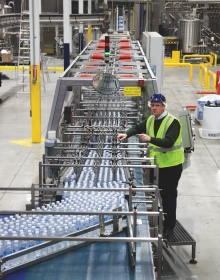
Photo by Sandra Strangemore
Turning water into wine must have been a pretty spectacular accomplishment back in the biblical days.
But it also takes something of a minor miracle in modern times not only to make a decent return from bottling one of Mother Nature’s finest-ever gifts to mankind, but to do it in a socially responsible, environmentally-sensitive way that flies in the face of the notion amongst some that the water-bottling industry is one of the greediest and most shameless corporate villains of the 21st Century.
Or in other words, to do it like Nestlé Waters Canada (NWC) does its at its sprawling water-bottling facility in the quiet southwestern Ontario rural community of Puslinch, where the Canadian subsidiary of the world’s largest food-and-beverage company Nestlé SA produces an estimated 70 million cases of bottled water annually—marketing them across Atlantic and central Canada under the company’s flagship Nestlé Pure Life and historic Montclair brands, along with co-packing a significant part of its output for the private-label store-brands of some of the country’s leading grocers and retailers.
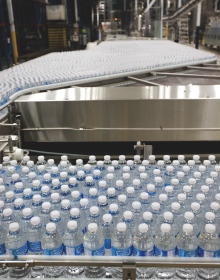
Photo by Sandra Strangemore
According to the company’s senior management team—headed by the recently-appointed NWC president John Zupo—the current public outcry over the water-bottling industry’s alleged wastefulness of resources, unacceptable environmental footprint and questionable ethics is rooted in over-the-top misinformation and use of selective facts that, any way you look at it, do not stand up to serious scrutiny.
Especially when viewed in the context of what NWC has achieved on the sustainability front over the last few years, contends Zupo, a 14-year Nestlé North America veteran and a Salt Lake City native who joined NWC in 2008 as general manager and was appointed as president last month.
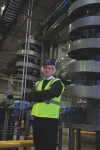
Photo by Sandra Strangemore
“The local water-bottling industry uses only 0.0014-percent of all the fresh water available in the province of Ontario, so we are not a significant user by any stretch,” Zupo told Canadian Packaging on a recent visit to the 350-employee, 400,000-square-foot Puslinch operation that ranks as one of Nestlé’s five biggest North American bottling plants, and the biggest beverage bottling plant in Canada.
Says Zupo: “Nestlé is a company that is keenly focused on constantly improving and doing better what it does on a day-to-day basis.
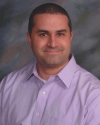
Photo by Sandra Strangemore
LONG JOURNEY
“It’s a continuous journey for us—whether we’re talking about being more environmentally-responsible, or being more efficient with our plant operations, or being better at serving our customers,” he states.
“And the truth is that we’re improving in all those areas,” he stresses. “ We are making better use of our water, we are achieving better recycling rates for our packaging, and we are now far more energy-efficient than in the past.”
By moving its former distribution center in Hamilton, Ont., into a new state-of-the-art, 125,000-square-foot warehouse in Puslinch two years ago, Zupo relates, “We have achieved significant savings in our trucking costs and the greenhouse emissions associated with those truckloads.
“We have also made significant investments on the energy and waste management sides of our business,” he adds. “When we put this new distribution center in here, we put in sensor-controlled lights that automatically turn on and off based on movement in the facility, and that has produced significant energy savings for us.
“We’ve also put in more natural light, we’ve changed the main lights in our plant ceiling to more energy-efficient lamps, and we’ve also changed the blowmolding practices by utilizing new nozzles that use considerably less energy,” he relates, “while also putting in new measurements for how we use water in our cleaning processes.”
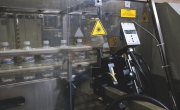
Photo by Sandra Strangemore
As for packaging, arguably the bottled-water industry’s biggest Achilles Heel and a public relations headache, Zupo cites NWC’s extensive recent investments in reducing the amount of plastic in its packaging, as well as deploying rPET (recycled polyethylene terephthalate) processing technologies, as proof of the company’s earnest commitment to the environmental cause.
For example, the recently-launched PET Eco-Shape 500-ml containers—weighing a mere 9.16-gram apiece—are 60 per cent lighter than the plastic bottles used back in 2000.
“Right now, about 96 percent of the recyclable materials used in our Canadian operations, including the British Columbia plant in Hope and our B.C., Ontario and Quebec warehouses, are already diverted from the wastestream,” Zupo notes, “and we’ve been reducing our water and energy usage by five to 15 per cent over the last couple of years, and those continue to be our targets right now.
“It’s all about achieving a combination of better distribution efficiencies, more packaging investment, and better energy and water usage,” says Zupo, citing these environmental improvements as main reasons for the Puslin
ch operation achieving the coveted, internationally-recognized ISO 14001 standards series certification last year for environmental management.
BIG PAYOFF
“I believe that our packaging initiatives are really paying off for us,” asserts Zupo.
“When we do consumer surveys, we find that the most important things to Canadian consumers are taste, quality and price,” he expands, “but the next most important thing is for them to know that their favorite bottled water brand is using environmentally-sensitive packaging, which is why we have reduced our packaging footprint so significantly over the last five years.
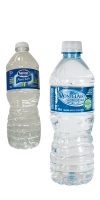
Photo by Sandra Strangemore
“I am also very confident that bringing out new rPET bottles to market is going to get a very positive response from the Canadian public,” he adds. “It is important to us that Canadian consumers see Nestlé products as high-quality, reliable brands produced by a brand-owner who is environmentally-progressive and doing all the right things for the environment.”
While Zupo acknowledges that the water-bottling industry has no shortage of vocal critics, “I really believe that there is all kinds of misinformation out there on the subject,” he argues.
“It’s been an interesting few years for us and the water bottling industry in general,” he reflects. “When this business first started taking off in the 1980s, it was the consumers wanting to drink something healthy that fueled the growth of the business.
“But around 2006, many questions started to be raised—just due to the sheer volumes of the water being bottled—about what would happen to the packaging,” Zupo recalls. “In survey after survey, that the single most consistent question that we get asked is: What are we doing about the packaging?
“Well, that fact is that Canada has a 64-percent recycling rate for beverage packages across the country, with some of the provinces achieving recycling rates of over 80 per cent,” Zupo points out, suggesting that those rates could be improved even further with a better recycling infrastructure in more public spaces like parks, arenas, entertainment venues, transit stop, streetscapes and gas bars.
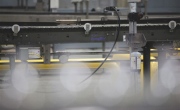
Photo by Sandra Strangemore
“By now, most of us have learned to use Blue Box recycling in our homes,” he says, “and we want to do it for all of our packaging, wherever it is used.
“In Toronto, something like 88 per cent of single-family households recycle their beverage bottles,” Zupo
notes, “but it’s when you’re out traveling in your car, or being out for a walk with your kids, or going to the shopping mall … that’s when recycling suffers, because you’re just happy to find a garbage can to get rid of the empty bottle.
“So our new focus has been on partnering with the municipalities to put recycling bins beside every single garbage can, so that when you see an opportunity to put your empty water bottles into the waste management stream, you will put it into the paper recycling part of that management stream.
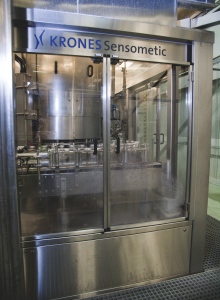
Photo by Sandra Strangemore
“By doing this in Quebec, we’ve been able to achieve 85-percent capture of recyclable materials there,” Zupo reveals, “and we have just finished a similar pilot project in Sarnia, Ont., achieving a 77-percent capture rate.
“The other thing that people often question is whether our water source are sustainable,” adds Zupo, “which is why we work closely with the Ontario Ministry of Environment and Natural Resources, Grand River Conservation Authority, County of Wellington and Township of Puslinch, sharing all our monitoring data with them.”
Zupo says the Puslinch plant collects key water-level data from more than 60 monitoring points located within one-kilometer radius of the facility, and is prepared to adjust its production levels accordingly in times of prolonged dry spells.
COMMUNAL SPIRIT
“We always look at are stewardship responsibilities from a community perspective,” he declares. “We understand that we are not the only ones here; there are two aggregate producers right next us who use roughly as much water as we take, and we always want to make sure that everyone has got enough, which is why we’re constantly monitoring the local water levels.”
Considering that Nestlé has only entered the Canadian bottled-water market a relatively short decade ago, already ranking as a runaway market leader—both in production volumes and a 38-percent market-share—is a fairly formidable accomplishment.

Photo by Sandra Strangemore
However, Zupo says he is not really all that surprised with NWC’s rapid ascent up the market ladder, citing the company’s enviable product portfolio, keen customer focus, and world-class manufacturing capabilities as equally important factors underpinning its success to date.
While its parent company’s venerable, world-renowned Perrier, San Pellegrino and Acqua Panna brands still account for nearly 30 per cent of NWC’s annual revenues, Zupo says that consolidating the production of Nestlé Pure Life and Montclair brands in Puslinch—where NWC currently produces over 60 different SKUs (stock-keeping units)—had the most profound impact in terms of transforming NWC from a distributor of co-packed products into a fully-fledged beverage producer.
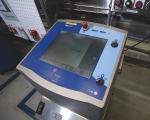
Photo by Sandra Strangemore
“Buying this plant in 2000, along with its fantastic 100-foot-deep spring, has really been a defining moment for us,” Zupo reflects.
“Having great brands is really the primary reason for our market-share leadership, and Nestlé Pure Life really is a great brand—currently being sold in more than 30 countries around the world—which is recognized in all our consumer surveys as the best-tasting spring water, as well as the most reliable from a safety perspective.
“The other key reason for our success is the great relationships and partnerships we cultivate with our customers to met their specific needs,” says Zupo, citing a Canadian customer base comprising over 145 leading retailers across the country.

Photo by Sandra Strangemore
“For large retailers, this may be about how we get their product to them, how we can help market and merchandise those products inside their stores, supplying the right SKUs for their locations and having the right price points,” he relates.
“For smaller customers, on the other hand, it may be more about having the right brands for their consumer demographics or supplying those brands in more consumer-friendly packaging,” says Zupo, adding that recent installations of new batching tanks at the Puslinch plant has enabled NWC to expand its brand portfolio with innovative new flavored and vitamin-enhanced water products.
As for the plant’s manufacturing prowess, “This is the largest, most technologically-advanced and the most productive bottling plant of its kind in Canada,” Zupo declares.

Photo by Sandra Strangemore
BUSY SCHEDULE
A committed practitioner of advanced manufacturing quality methodologies such as Six Sigma and GMP (Good Manufacturing Practices), the Puslinch plant operates in 12-hour shifts on a flat-out, 24/7 schedule over the full year—with exceptions for Christmas Day and the occasional Canada Day off—using nothing but the most advanced, best-in-breed packaging technologies, materials and supplies available in the market.
Moreover, the plant employs a total of 10 Sidel blowmolders, as well as several Husky injection-molding machines, on its premises to make all of its containers right on-site—including the 330-, 500- and 750-ml bottles, as well as the larger one- and 1.5-liter sizes. “It is very much a seasonal business: We sell far more water in the summer than we do in the winter,” says Zupo, explaining that the plant typically starts to shift its production schedule into overdrive mode around mid-March to make sure that doesn’t run into any unexpected supply shortages during the upcoming peak season, typically lasting from the Victoria Day long-weekend in May through the Labor Day long-weekend in early September.

Photo by Sandra Strangemore
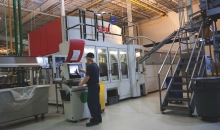
Photo by Sandra Strangemore
“We pride ourselves on our manufacturing and packaging capabilities and we do our best to use as many
Canadian-based packaging suppliers as we can,” says NWC supply chain director David Thorpe, complimenting corrugated packaging suppliers Atlantic Packaging Products and Norampac, caps and closures manufacturer Bericap North America Inc., flexible packaging producer Transco Plastics, industrial chemicals distributors Brenntag and Univar, and plastic resins supplier Eastman Chemical Company for their superior customer service.
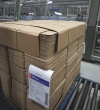
Photo by Sandra Strangemore
“The consumer and customer response to our packaging has been excellent to date,” says Thorpe, “and our packaging partners naturally deserve a large share of the credit for that.”
While the water bottling business currently accounts for a relatively smallish, eight-percent share of Nestlé SA’s massive worldwide revenues of about $100 billion, Zupo maintains that the water business is very close to the heart of a company that markets itself around the globe as the world’s foremost supplier of “nutri
tion, wellness and hydration products.”
Says Zupo: “Nestlé today does water business on every continent, but it’s quite fascinating how it evolved historically in the different parts of the world.
“In Europe, for example, it traces back to the 1700s, focusing on the health benefits of spas and the health benefits of drinking water to maintain good health.
“In Third World countries, bottled water is consumed more for safety considerations, because the tap water there is just not as consistently portable as in the industrialized nations,” he observes.
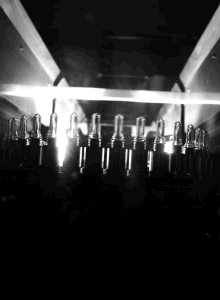
Photo by Sandra Strangemore
“But here in North America, the consumer emphasis is more about diet, fitness, and moving away from soft-drinks and other calorie-laden beverages to achieve optimal hydration,” Zupo states.
“People today understand that water is something they need to drink to keep their bodies hydrated, and they’re looking for good-quality, clean water to help them achieve that hydration safely, without all those extra calories,” Zupo sums up.
“And as long as that continues to be the case, we’ll be happy to keep providing consumers with good-tasting, safe drinking water that is actually good and healthy for them.”
Advertisement

